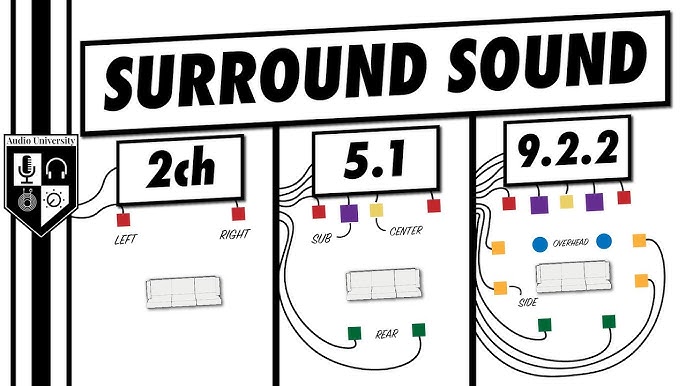Blog
Understanding Surround Sound: A Guide to 5.1 and 7.1 Speakers
When it comes to creating an immersive audio experience, surround sound is a crucial factor that takes your entertainment setup to the next level. Whether you’re gaming, watching movies, or listening to music, the right surround sound system can elevate your experience by adding depth and realism. Two of the most common configurations for surround sound speakers are 5.1 and 7.1 systems. In this guide, we’ll break down the differences between these two setups and explain how each one contributes to a more immersive audio experience.

What is Surround Sound?
Surround sound refers to a multi-speaker audio system designed to surround the listener with sound from multiple directions. This system mimics the way we hear sounds in real life, giving a more natural, three-dimensional feel to the audio. The goal is to make you feel like you’re in the middle of the action, whether it’s a high-speed car chase, an epic battle, or a live concert.
The 5.1 Surround Sound System
A 5.1 surround sound system is one of the most popular and widely used configurations for home entertainment. The “5” in 5.1 refers to the five main speakers, while the “1” represents the subwoofer, which handles the low frequencies (bass).
Components of a 5.1 System:
- Front Left and Right Speakers: These are placed at the front of the room on either side of your TV or projector. They handle the majority of the sound and are responsible for delivering clear dialogues, music, and action sounds.
- Center Channel Speaker: Positioned directly in front of the viewer, this speaker is responsible for delivering dialogue and central sound effects. It ensures that voices and key sounds remain clear, regardless of where you sit in the room.
- Rear Left and Right Speakers: These speakers are placed behind the viewer, typically to the left and right. They deliver ambient sounds, sound effects, and contribute to the sense of directionality in the audio, helping you perceive the movement of objects or characters in the game or movie.
- Subwoofer: This is the “.1” in the 5.1 setup. The subwoofer is responsible for low-frequency sounds, like explosions, deep bass music, or the rumble of thunder. It provides the physical depth to the sound, making the experience more impactful.
Advantages of a 5.1 System:
- Cost-effective: Since it requires fewer speakers, a 5.1 system is generally more affordable than more advanced setups.
- Compact setup: It’s easier to arrange and more suitable for smaller rooms.
- Ideal for movies and gaming: It delivers a good balance of audio quality and immersion for typical home entertainment.

The 7.1 Surround Sound System
A 7.1 surround sound system offers an expanded version of the 5.1 setup, with two additional speakers. This configuration provides an even more immersive audio experience, especially for large rooms or dedicated home theaters.
Components of a 7.1 System:
In addition to the components of a 5.1 system, a 7.1 setup includes:
- Additional Rear Left and Right Speakers: These speakers are placed further behind the viewer, offering more precise rear sound imaging and a wider sound field.
- Side Surround Left and Right Speakers: These speakers are placed to the left and right of the seating area, typically at ear level. They enhance the sense of movement from left to right and contribute to the overall spatial experience.
Advantages of a 7.1 System:
- Better immersion: The extra speakers help create a more three-dimensional sound experience, ideal for large rooms where you want every corner of the space to be filled with sound.
- Improved sound accuracy: The additional rear and side speakers allow for more accurate sound placement, making it easier to pinpoint the location of sounds in your environment.
- Great for high-definition content: If you’re watching Blu-ray movies, 4K content, or playing high-end games, a 7.1 system can deliver the superior sound quality needed to experience the full depth of the audio.
5.1 vs 7.1: Which One Should You Choose?
The decision between a 5.1 and a 7.1 surround sound system depends on several factors, including the size of your room, your budget, and how immersive you want your audio experience to be.
- Room Size: For smaller rooms, a 5.1 system might be sufficient. The added complexity of a 7.1 setup could overwhelm a smaller space and potentially cause sound to become muddled or difficult to distinguish. However, for larger rooms or dedicated home theaters, a 7.1 system offers a more expansive sound field.
- Budget: A 5.1 system is typically more affordable due to fewer components, making it an excellent choice for those on a budget who still want high-quality sound. A 7.1 system, on the other hand, will generally cost more due to the additional speakers and increased complexity of setup.
- Type of Content: If you mostly watch movies, a 5.1 system will provide a satisfying experience for most content. However, if you’re into gaming or enjoy high-definition movies with surround sound, a 7.1 system will take your audio experience to the next level.

Conclusion
Both 5.1 and 7.1 surround sound systems offer incredible audio experiences, with each having its own strengths. A 5.1 system is ideal for most users, providing great sound without overwhelming the room or budget. However, if you’re looking for the ultimate in immersive audio and have the space and budget for it, a 7.1 system can provide a more expansive and detailed experience. No matter which option you choose, investing in surround sound will transform your gaming, movie-watching, and music-listening sessions, bringing them to life like never before.

